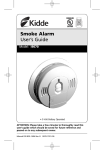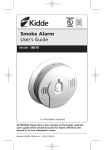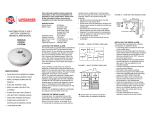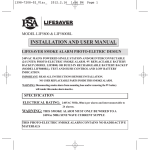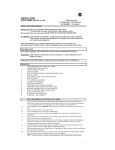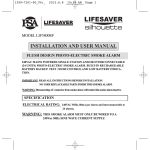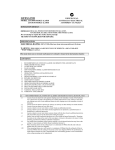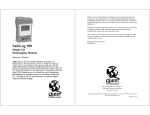Download Photoelectric Smoke Alarm
Transcript
9 Volt Battery-Operated Photoelectric Smoke Alarm Manual Model LIFPE9 and LIFPE9H Ionisation sensing alarms may detect invisible fire particles (associated with fast flaming fires) sooner than photoelectric alarms. Photoelectric sensing alarms may detect visible fire particles (associated with slow smoldering fires) sooner than ionisation alarms. Home fires develop in different ways and are often unpredictable. For maximum protection, both ionisation and photoelectric alarms should be installed. Made in China. Patents Pending 820-1239 Rev. A 0306-7204-00 Contents Introduction . . . . . . . . . . . . . . . . . . . . . . . . . 1 Installation . . . . . . . . . . . . . . . . . . . . . . . . . . 2–9 Operation . . . . . . . . . . . . . . . . . . . . . . . . . . . 10–13 Maintenance . . . . . . . . . . . . . . . . . . . . . . . . . 14 Fire Safety . . . . . . . . . . . . . . . . . . . . . . . . . . 15–18 Warranty . . . . . . . . . . . . . . . . . . . . . . . . . . . . 19 Introduction Model LIFPE9 and LIFPE9H If you have any questions about the operation or installation of your alarm, please call 1300 PSA Products. Image 1C will help you determine the correct location of safety products that will help make your home a safer place. WARNING! Removal of the smoke alarm battery will render the smoke alarm inoperative. IMPORTANT! Read all instructions before installation and keep this manual near the alarm for future reference. 1 Installation Instructions Recommended Locations • Locate the first alarm in the immediate area of the bedrooms. Try to monitor the exit path, as the bedrooms are usually farthest from the exit. If more than one sleeping area exists, locate additional alarms in each sleeping area (Image 1A). • Locate additional alarms to monitor any stairway as stairways act like chimneys for smoke and heat. • Locate at least one alarm on every floor level (Image 1B). • Locate an alarm in every bedroom. • Locate an alarm in every room where electrical appliances are operated (i.e. portable heaters or humidifiers). • Locate an alarm in every room where someone sleeps with the door closed. The closed door may prevent an alarm located outside from waking the sleeper. • Smoke, heat, and combustion products rise to the ceiling and spread horizontally. Mounting the smoke alarm on the ceiling in the centre of the room places it closest to all points in the room. Ceiling mounting is preferred in ordinary residential construction. • When mounting an alarm on the ceiling, locate it at a minimum of 10 cm (4 in) from the side wall (Image 2A). • For mobile home installation, select locations carefully to avoid thermal barriers that may form at the ceiling. For more details, see MOBILE HOME INSTALLATION on page 4. Please note, model LIF9 is not suitable for installing in caravans or mobile homes. Only Lifesaver models LIF9H, LIF1926, LIFPE9 and LIFPE9H are suitable for installing in caravans or mobile homes. • When mounting the alarm on the wall, use an inside wall with the top edge of the alarm at a minimum of 10 cm (4 in) and a maximum of 30.5 cm (12 in) below the ceiling (Image 2A). • Put smoke alarms at both ends of a bedroom hallway or large room if the hallway or room is more than 9.1 m (30 ft) long. 2 Installation SINGLE FLOOR PLAN MULTIPLE FLOOR PLAN IMAGE 1A IMAGE 1B • Install smoke alarms on sloped, peaked or cathedral ceilings at or within 0.9 m (3 ft) of the highest point (measured horizontally). Smoke alarms in rooms with ceiling slopes greater than 0.3 m in 2.4 m (1 ft in 8 ft) horizontally shall be located on the high side of the room. A row of alarms shall be spaced and located within 0.9 m (3ft) of the peak of the ceiling measured horizontally (see Image 2B). IMAGE 1C 3 TOTAL HOME PROTECTION Installation • Mobile Home Installation Mobile homes built in the past five to seven years have been designed to be energy efficient. Install smoke alarms as recommended above (refer to RECOMMENDED LOCATIONS and Diagram 2A). In mobile homes that are not well insulated compared to present standards, extreme heat or cold can be transferred from the outside to the inside through poorly insulated walls and roof. This may create a thermal barrier which can prevent the smoke from reaching an alarm mounted on the ceiling. In such units, install the smoke alarm on an inside wall with the top edge of the alarm at a minimum of 4” (10cm) and a maximum of 12” (30.5cm) below the ceiling (see Diagram 2A). If you are not sure about the insulation in your mobile home, or if you notice that the outer walls and ceiling are either hot or cold, install the alarm on an inside wall. For minimum protection, install at least one alarm close to the bedrooms. For additional protection, see SINGLE FLOOR PLAN in Diagram 1A. WARNING: TEST YOUR SMOKE ALARM OPERATION AFTER CARAVAN OR MOBILE HOME VEHICLE HAS BEEN IN STORAGE, BEFORE EACH TRIP AND AT LEAST ONCE A WEEK DURING USE. 4 Installation Locations to Avoid • Do not install within 0.9 m (3 ft) of the following: The door to a kitchen, or a bathroom that contains a tub or shower, forced air supply ducts used for heating or cooling, ceiling or whole house ventilating fans, or other high air-flow areas. • Do not place the alarm where drapes or other objects will block the sensor. Smoke must be able to reach the sensor to accurately detect conditions. • Do not install in peaks of vaulted ceilings, “A” frame ceilings or gabled roofs. (Less than 10 cm (4 in) from the peak of an “A” frame type ceiling.) • Install at least 30.5 cm (12 in) away from fluorescent lights as electronic noise may cause nuisance alarms. • Keep out of insect infested areas. Avoid excessively dusty, dirty or greasy areas. Dust particles may cause nuisance alarms or failure to alarm. • Extreme temperatures may effect the sensitivity of the alarm. Do not install in areas where the temperature is colder than 5°C or hotter than 45°C, such as garages and unfinished attics. • Do not install in areas where the relative humidity (RH) is greater than 85%. Very humid areas, with moisture or steam, can cause nuisance alarms. • Avoid placing smoke alarms in kitchen areas. Normal cooking may cause nuisance alarms. If a kitchen alarm is desired, it should have an alarm silencer feature or be a photoelectric type. • Do not place in the garage. Particles of combustion are present when you start your automobile. • Smoke alarms are not to be used with detector guards unless the combination (alarm and guard) has been evaluated and found suitable for that purpose. 5 Installation 10 cm (4 in) MINIMUM CEILING BEST PLACEMENT IMAGE 2A NEVER HERE ACCEPTABLE PLACEMENT SIDE WALL NOT IN THIS AREA 10 cm (4 in) ANYWHERE IN THIS AREA 0.9 m (3 ft) 0.9 m (3 ft) HORIZONTAL DISTANCE FROM PEAK NOT IN THIS AREA ANYWHERE IN THIS AREA IMAGE 2B 10 cm (4 in) 0.9 m (3 ft) 6 Installation Mounting CAUTION: This unit is sealed. The cover is not removable! • Remove the mounting plate from the back of the alarm by holding the plate and twisting the alarm in the direction indicated by the “OFF” arrow on the alarm cover. • After selecting the proper smoke alarm location as described previously, hold the mounting plate against the selected installation location (wall or ceiling) and mark the centre of the holes with a pencil. To ensure aesthetic alignment of the alarm with the hallway, or wall, the “A” line on the mounting plate should be parallel with the hallway when ceiling mounted, or horizontal when wall mounted (Image 3A and 3B). Drill a hole through the pencil marks and use the enclosed screws and anchors to secure the mounting plate. Use a 3/16 inch drill bit for the screw anchor holes. • Press the battery reminder tab down into the battery compartment while inserting the battery (Image 3E). CAUTION: If the battery reminder tab is not held down in the battery compartment by the battery, the unit will not attach to the mounting plate. • Alignment marks are provided on the edge of the mounting plate and the alarm. After installing the mounting plate, place the alarm onto the mounting plate, making sure the alignment marks are lined up. Twist the alarm in the direction indicated by the “ON” arrow on the alarm cover (Image 3D) until it locks in place. 7 Installation “A” LINE ALIGNMENT MARKS IMAGE 3B IMAGE 3A WALL MOUNTING POSITION ROTATE TO MOUNT OR TO REMOVE IMAGE 3C IMAGE 3D BATTERY REMINDER TAB IMAGE 3E 8 Installation Alarm Tamper-Resist Feature • To make the smoke alarm tamper-resistant, a tamper resist means has been provided. To activate this feature you must break out the tamper-resist blocks on the mounting plate (Image 4A). Use a small screwdriver. • Using this feature will help deter children and others from removing the alarm from the mounting plate. With the blocks removed, the tamper-resist feature will be activated when the alarm is installed on the mounting plate. • The tamper-resist tab will have to be released in order to change the battery. Using a tool (small screwdriver) push the tab away from the mounting plate (Image 4B) and rotate the alarm in the “OFF” direction. • After installation, test the alarm by depressing and holding down the Test button for several seconds. This should sound the alarm. BREAK OUT IMAGE 4A 9 IMAGE 4B Operation Testing The smoke alarm is operating once a fresh battery is installed and testing is complete. When the smoke alarm photoelectric sensor chamber senses products of combustion, the horn will sound a loud (85 db) alarm until the sensing chamber is cleared of smoke particles. • Test the unit to ensure proper operation by pressing the Test button for at least 5 seconds (or until the unit sounds). This will sound the alarm if the electronic circuitry, horn, and battery are working. If no alarm sounds, the unit has a defective battery or other failure. DO NOT use an open flame to test your alarm, you could damage the alarm or ignite combustible materials and start a fire. CAUTION: Due to the loudness (85 decibels) of the alarm, always stand an arms-length away from the unit when testing. Test the alarm weekly to ensure proper operation. Erratic or low sound coming from your alarm may indicate a defective alarm, and it should be returned for service (see Warranty section). NOTE: WEEKLY TESTING IS REQUIRED. 10 Operation LED Indicators This alarm is equipped with a red LED indicator, with two modes of operation. Red LED - Flashing every 40–45 seconds: Indicates that the smoke alarm is operating properly. Red LED - Flashing: When the Test button is pressed, or when the smoke alarm senses particles of combustion and goes into alarm (constant pulsating sound), the red LED will flash once per second. The flashing LED and pulsating alarm will continue until the air is cleared. Alarm Memory This smoke alarm has a memory function that will inform you if the alarm has sounded since the Test button was last pressed. The alarm memory will cause the red LED to flash rapidly when the test button is pressed. The alarm memory is reset when the Test button is released. Testing CAUTION: Due to the loudness (85 decibels) of the alarm, always stand an arms length away from the unit when testing. Test by pushing the Test button on the cover and hold it down for a minimum of 5 seconds. This will sound the alarm if all the electronic circuitry, horn and battery are working. If no alarm sounds, the unit has a defective battery or some other failure. DO NOT use an open flame to test your alarm, you could damage the alarm or ignite combustible materials and start a fire. Test the alarm weekly to ensure proper operation. Erratic or low sound coming from your alarm may indicate a defective alarm, and it should be returned for service (see Warranty section). NOTE: WEEKLY TESTING IS REQUIRED. 11 Operation Alarm Silencer (Hush®) available on LIFPE9H only Smoke alarms are designed to minimise nuisance alarms. Cigarette smoke will not normally set off the alarm, unless the smoke is blown directly into the alarm. Combustion particles from cooking may set off the alarm if the alarm is located close to the cooking area. Large quantities of combustible particles are generated from spills or when broiling. Using the fan on a range hood that vents to the outside (non-recirculating type) will also help remove these combustible particles from the kitchen. The alarm silencer (Hush® button) is extremely useful in a kitchen area or other areas prone to nuisance alarms. The alarm silencer (Hush®) has the capability of temporarily desensitising the alarm circuit for up to 8 minutes. This feature is to be used only when a known alarm condition, such as smoke from cooking, activates the alarm. If the alarm does sound, check for fires first. If a fire is discovered, get out and call the fire brigade. If no fire is present, check to see if one of the reasons listed in Locations to Avoid may have caused the alarm. The smoke alarm is desensitised by pushing the alarm silencer (Hush® button) on the smoke alarm cover. If the smoke is not too dense, the alarm will silence immediately. The red LED will Illuminate every 1.5 seconds to indicate that the alarm is in a temporarily desensitised condition. The smoke alarm will automatically reset after approximately 8 minutes. If after this period particles of combustion are still present, the alarm will sound again. The alarm silencer (Hush®) can be used repeatedly until the air has been cleared of the condition causing the alarm. Pushing the Test button on the alarm will end the alarm silencer (Hush®) period. NOTE: Dense smoke will override the alarm silencer (Hush®) and sound a continuous alarm. CAUTION: Before using the alarm silencer (Hush®), identify the source of the smoke and be certain a safe condition exists. 12 Operation Alarm Removal To remove the alarm from the mounting plate, rotate the alarm in the direction of the “OFF” arrow on the cover. If the tamper-resist feature has been used, refer to Alarm Tamper-Resist Feature section for removal instructions. Maintenance This smoke alarm uses a 9 volt battery (carbon zinc, alkaline and lithium batteries may be used). A fresh battery should last for one year under normal operating conditions. This alarm has a low battery monitor circuit which will cause the alarm to “chirp” approximately every 30-40 seconds for a minimum of seven (7) days when the battery gets low. Replace the battery when this condition occurs. The low battery chirp will occur at the same time as the red LED flash. Smoke Sensing Chamber Operation This alarm will “chirp” if it detects a problem with the smoke sensing chamber. This chirp will occur approximately 20 seconds after the flash of the red LED indicator light. Use only the following 9 volt batteries for replacement: Carbon-Zinc Type Eveready 1222; Gold Peak 1604P or 1604S Alkaline Type Energizer 522 Duracell MN1604 or MX1604 Gold Peak 1604A Panasonic 6AM6, 6AM-6, 6AM-6PI, 6AM6X or 6LR61(GA) Lithium Type Ultralife U9VL-J These batteries can be purchased at your local retailer. WARNING! Use only the batteries specified above. Use of different batteries than the recommended ones, may have a detrimental effect on the smoke alarm. A good safety measure is to replace the battery at least once a year, or at the same time you change your clocks for daylight saving time. Be sure to follow the battery installation instructions printed on the back of the alarm. NOTE: REGULAR WEEKLY TESTING IS REQUIRED! 13 Maintenance Cleaning the Alarm The alarm should be cleaned at least once a year. • To clean your alarm, remove it from the mounting plate as outlined in previous sections. You can clean the alarm by using compressed air or a vacuum cleaner hose with a soft brush attachment. Blow or vacuum around the perimeter of the alarm to remove dust and dirt. The outside of the alarm can be wiped with a damp cloth (do not use a wet cloth to avoid water entering the unit). • After cleaning, reinstall your alarm and test your alarm by using the Test button. If cleaning does not restore the alarm to normal operation, the alarm should be replaced. • Do not paint the unit. Paint will seal the vents and interfere with the sensor’s ability to detect smoke. Never attempt to disassemble the unit or clean inside. This action will void your warranty. Replacing the Alarm It is recommended this alarm be replaced ten years from the date of manufacture. For your convenience, this date has been provided to you on a label located on the side of the alarm. 14 Fire Safety WARNING: Please read carefully and thoroughly. • Life safety from fire in residential occupancies is based primarily on early notification to occupants of the need to escape, followed by the appropriate egress actions by those occupants. Fire warning systems for dwelling units are capable of protecting about half of the occupants in potentially fatal fires. Victims are often intimate with the fire, too old or young, or physically or mentally impaired such that they cannot escape even when warned early enough that escape should be possible. For these people, other strategies such as protection-in-place or assisted escape or rescue are necessary. • Smoke alarms are devices that can provide early warning of possible fires at a reasonable cost; however, alarms have sensing limitations. Ionisation sensing alarms may detect invisible fire particles (associated with fast flaming fires) sooner than photoelectric alarms. Photoelectric sensing alarms may detect visible fire particles (associated with slow smoldering fires) sooner than ionisation alarms. Home fires develop in different ways and are often unpredictable. For maximum protection, both ionisation and photoelectric alarms should be installed. • A battery powered alarm must have a battery of the specified type, in good condition and installed properly. • AC powered alarms (without battery backup) will not operate if the AC power has been cut off, such as by an electrical fire or an open fuse. • Smoke alarms must be tested regularly to make sure the batteries and the alarm circuits are in good operating condition. • Smoke alarms cannot provide an alarm if smoke does not reach the alarm. Therefore, smoke alarms may not sense fires starting in chimneys, walls, on roofs, on the other side of a closed door or on a different floor. • If the alarm is located outside the bedroom or on a different floor, it may not wake up a sound sleeper. 15 Fire Safety • The use of alcohol or drugs may also impair one’s ability to hear the smoke alarm. For maximum protection, a smoke alarm should be installed in each sleeping area on every level of a home. • Although smoke alarms can help save lives by providing an early warning of a fire, they are not a substitute for an insurance policy. Home owners, landlords and tenants should have adequate insurance to protect their lives and property. Good Safety Habits Develop and practice a plan of escape! • Install and maintain Fire extinguishers on every level of the home and in the kitchen, basement and garage. Know how to use a fire extinguisher prior to an emergency. • Make a floor plan indicating all doors and windows and at least two (2) escape routes from each room. Second story windows may need an escape ladder. • Have a family meeting and discuss your escape plan, showing everyone what to do in case of fire. • Determine a place outside your home where you all can meet if a fire occurs. • Familiarize everyone with the sound of the smoke alarm and train them to leave your home when they hear it. • Practice a fire drill at least every six months, including fire drills at night. Ensure that small children hear the alarm and wake when it sounds. They must wake up in order to execute the escape plan. Practice allows all occupants to test your plan before an emergency. You may not be able to reach your children. It is important they know what to do. 16 Fire Safety Alarm Exit Procedure • Alert small children in the home. • Leave immediately by your escape plan. Every second counts, so don’t waste time getting dressed or picking up valuables. • In leaving, don’t open any inside door without first feeling its surface. If hot, or if you see smoke seeping through cracks, don’t open that door! Instead, use your alternate exit. If the inside of the door is cool, place your shoulder against it, open it slightly and be ready to slam it shut if heat and smoke rush in. • Stay close to the floor if the air is smoky. If possible do not breathe too deeply to avoid smoke inhalation. Breathe through a cloth (preferably wet) if possible. • Once outside, go to your selected meeting place and make sure everyone is there. • Call the fire brigade from your neighbor’s home - not from yours! • Don’t return to your home until the fire officials say that it is all right to do so. • There are situations where a smoke alarm may not be effective to protect against fire. For instance: - smoking in bed; - leaving children unsupervised; - cleaning with flammable liquids, such as gasoline. 17 Fire Safety Additional Information Smoke Detection. Where required by applicable laws, codes, or standards for the specified occupancy, approved single- and multiple-station smoke alarms shall be installed as follows: (1) In all sleeping rooms Exception: Smoke alarms shall not be required in sleeping rooms in existing one- and two-family dwelling units. (2) Outside of each separate sleeping area, in immediate vicinity of the sleeping rooms. (3) On each level of the dwelling unit, including basements Exception: In existing one- and two-family dwelling units, approved smoke alarms powered by batteries are permitted. Smoke Detection - Are More Smoke Alarms Desirable? The required number of smoke alarms might not provide reliable early warning protection for those areas separated by a door from the areas protected by the required smoke alarms. For this reason, it is recommended that the householder consider the use of additional smoke alarms for those areas for increased protection. The additional areas include the basement, bedrooms, dining room, furnace room, utility room, and hallways not protected by the required smoke alarms. The installation of the smoke alarms in the kitchen, attic (finished or unfinished), or garage is normally not recommended, as these locations occasionally experience conditions that can result in improper operation. Notify your local fire brigade and insurance company of your smoke alarm installation. 18 Warranty Your Smoke Alarm Warranty PSA Products warrants to the original purchaser of each new smoke alarm to be free from defects in materials and workmanship, under normal use and services, for a period of five (5) years from the date of purchase. This warranty does not extend to the battery. The company will not be obligated to repair or replace parts which are found to be in need of repair, or replace parts because of misuse, damage, or alteration incurred after date of purchase. PSA Products agrees to repair or replace, at its option, any defective smoke alarm provided that it is returned with proof of purchase and return postage prepaid to PSA Products. To the extent permitted by law, the liability of PSA Products arising from the sale of this smoke alarm or under the terms of this limited warranty, shall not in any case exceed the cost of a replacement smoke alarm and subject to this clause. In no case shall PSA Products be liable for consequential loss or damages resulting from the failure of the smoke alarm or breach of this,or any other warranty, expressor implied, loss or damage caused by failure to abide by the instructions supplied in this user manual. This warranty is an addition to and does not exclude the rights of consumers under the Australian Trade Practices Act 1974, or any other law which may not be excluded . ALTHOUGH A SMOKE ALARM CAN HELP SAVE LIVES BY PROVIDING AN EARLY WARNING OF A FIRE. IT IS NOT A SUBSTITUTE FOR PROPERTY INSURANCE OR LIFE INSURANCE OF ANY KIND. APPROPIATE INSURANCE COVER IS THE RESPONSIBILITY OF THE HOME OWNER. Another Quality Product By: 17 Millicent Street, Burwood, Victoria 3125, Australia Ph: (03) 9888 9889 Fax: (03) 9888 9993 E-mail: [email protected] Website: www.psaproducts.com.au 19
























